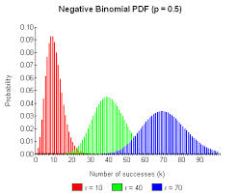Normal Approximation for the Binomial Distribution
Instructions: Compute Binomial probabilities using Normal Approximation. Please type the population proportion of success p, and the sample size n, and provide details about the event you want to compute the probability for (notice that the numbers that define the events need to be integer. Also, if the event contains the sign "<", make sure to replace it by the equivalent event using \(\le\). For example, if you need \( \Pr(X < 6)\), compute instead \( \Pr(X \le 5)\)):
Binomial Probability Calculator using Normal Approximation
For a random variable \(X\) with a Binomial distribution with parameters \(p\) and \(n\), the population mean and population variance are computed as follows:
\[ \mu = n \cdot p \] \[ \sigma = \sqrt{n \cdot p \cdot (1 - p)} \]When the sample size \(n\) is large enough, and/or when \(p\) is close to \(\frac{1}{2}\), then \(X\) is approximately normally distributed. But in order to approximate a Binomial distribution (a discrete distribution) with a normal distribution (a continuous distribution), a so called continuity correction needs to be conducted. Specifically, a Binomial event of the form
\[ \Pr(a \le X \le b) \]will be approximated by a normal event like
\[ \Pr(a - \frac{1}{2} \le X_{Normal} \le b + \frac{1}{2}) \]Using the above binomial distribution curve calculator , we can approximate the probabilities of the form \(\Pr(a \le X \le b)\), of the form \(\Pr(X \le b)\) or of the form \(\Pr(X \ge a)\). This can be practical when attempting to make hand calculations that would involve large intervals, which would imply calculating many individual probabilities. For an exact Binomial probability calculator, please check this one out , where the probability is exact, not normally approximated.
Other normal approximations
There is a less commonly used approximation which is the normal approximation to the Poisson distribution , which uses a similar rationale than that for the Poisson distribution.



